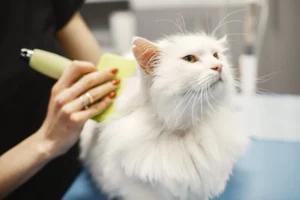Have you ever caught your cat frantically chasing something that isn’t there? It’s a common sight for cat owners, leaving many wondering what is going on in their feline companion’s mind. In this blog post, we will explore the reasons behind why your cat may be chasing nothing.
Natural Instincts: Understanding Your Cat’s Hunting Behavior
Cats, being the natural hunters that they are, have a strong instinct to chase after prey. Even if your cat is chasing nothing visible to you, rest assured that they are simply acting on their innate predatory instincts. Their keen senses and reflexes are always on the lookout for potential prey, whether real or imaginary.
One important thing to understand is that cats are crepuscular hunters, meaning they are most active during dawn and dusk. This is when they are most likely to exhibit chasing behavior, as their predatory instincts kick in. So, if you notice your cat chasing shadows or invisible critters during these times, it’s completely normal and just a part of their natural behavior.
If you want to encourage your cat’s hunting instincts in a safe way, consider providing them with interactive toys that mimic prey. This can help satisfy their natural instincts while keeping them entertained and mentally stimulated.
For more information on cat behavior and hunting instincts, feel free to check out this helpful resource from the American Association of Feline Practitioners: Cat Behavior Basics: Prey Drive and Predatory Behavior.
Environmental Stimuli: Exploring Triggers for Chasing Behavior
Have you ever noticed your cat staring intently at something that seems invisible to you? It’s likely that they are fixated on a shadow, reflection, or even a speck of dust that has caught their attention. Cats have incredibly sharp vision and are sensitive to even the slightest movements, making them prone to chasing after these seemingly invisible prey.
In addition to shadows and reflections, other environmental stimuli that can trigger your cat’s chasing behavior include flickering lights, laser pointers, or even the movement of curtains in the breeze. These triggers can activate your cat’s hunting instincts, prompting them to engage in playful chasing behavior.
If your cat’s chasing behavior seems excessive or concerning, it’s always a good idea to consult with your veterinarian. They can rule out any underlying health issues and provide guidance on how to manage your cat’s behavior effectively.
Remember, understanding the natural instincts and triggers behind your cat’s chasing behavior can help you better appreciate their unique behaviors and provide them with enriching experiences in your home.
Play and Exercise: The Benefits of Chasing Games
Does your cat seem to be on a mission to catch invisible prey around the house? Don’t worry, this behavior isn’t as strange as it may seem. Cats have a natural instinct to hunt and chase, even if there’s nothing visible to pursue. Chasing games can actually be a great way for your feline friend to stay active and engaged.
Engaging in play and exercise is essential for a cat’s physical and mental well-being. Chasing games can help your cat burn off excess energy, maintain a healthy weight, and prevent boredom. Additionally, these activities can strengthen the bond between you and your cat, providing a fun and interactive way to spend quality time together.
Next time you see your cat darting around after an imaginary target, grab a toy or a laser pointer and join in on the fun. Not only will it satisfy your cat’s natural instincts, but it will also promote a happy and healthy lifestyle for your furry companion.
Health Concerns: Addressing Potential Medical Issues
While it’s normal for cats to engage in playful chasing behavior, there are instances where excessive or unusual chasing could indicate an underlying health issue. If your cat is obsessively chasing nothing, it’s important to consider the possibility of medical concerns.
Hyperthyroidism, which can cause increased activity levels in cats, or vision problems that make them see things that aren’t there, could be potential reasons for your cat’s erratic behavior. If you notice a sudden change in your cat’s chasing habits or if they seem distressed while engaging in this behavior, it’s best to consult your veterinarian for a thorough examination.
Remember, understanding your cat’s behavior is key to ensuring their health and happiness. By staying observant and proactive, you can address any potential medical issues early on and provide the best care for your beloved pet.
Mental Stimulation: Keeping Your Cat Engaged
Cats chasing invisible prey could indicate a need for mental stimulation. To keep your feline friend engaged, consider investing in interactive toys like laser pointers, puzzle feeders, or feather wands. These toys can mimic hunting behaviors, providing a healthy outlet for your cat’s natural instincts and helping to prevent boredom-induced chasing. Additionally, rotating toys regularly can prevent them from becoming stale and keep your cat entertained. Providing vertical spaces for climbing, such as cat trees or shelves, can also offer mental stimulation and exercise. Regular play sessions with your cat using these engaging toys can help curb excessive chasing behavior and strengthen the bond between you and your furry companion.
Ways to Keep Your Cat Engaged:
- Interactive toys like laser pointers, puzzle feeders, and feather wands
- Rotating toys to prevent boredom
- Vertical spaces for climbing and exploration
When to Seek Help: Recognizing Red Flags
While a cat chasing nothing may seem harmless, it’s essential to monitor for any concerning behaviors. If your cat’s chasing behavior becomes obsessive, occurs frequently throughout the day, or is accompanied by other signs of distress like aggression or changes in appetite, it may be time to seek help from a veterinarian. These behaviors could indicate underlying health issues, such as anxiety, hyperthyroidism, or vision problems, that require professional evaluation and treatment. Seeking veterinary guidance can help address any medical or behavioral issues contributing to your cat’s chasing behavior, ensuring the best possible care for your beloved pet. Remember, early intervention is key to maintaining your cat’s health and well-being.
Red Flags to Watch for:
- Obsessive chasing behavior
- Frequent chasing throughout the day
- Signs of distress like aggression or changes in appetite
For more information on cat behavior and health, consider consulting with a trusted source like the American Association of Feline Practitioners (AAFP). Their website offers valuable resources and expert advice on caring for your cat’s well-being.
Fun Facts About Cat Behavior
Did you know that your cat’s instinct to chase things, even when there’s nothing there, can be traced back to their hunting ancestors? Cats are natural predators and possess a strong prey drive, which leads them to engage in playful chasing behaviors, even with imaginary “prey.”
Another interesting fact is that when cats chase after nothing, it can actually be a form of exercise and mental stimulation for them. It helps them release pent-up energy, stay active, and prevent boredom. So next time you see your cat zipping around the house after an invisible target, know that they’re just keeping themselves entertained.
Interestingly, some cats may also exhibit this behavior due to heightened senses. Cats have incredibly acute hearing and vision, so they might be picking up on subtle sounds or movements that are imperceptible to us. This heightened sensitivity can cause them to react as if they’re chasing something real.
In addition, this playful behavior can also be a way for cats to practice their hunting skills. By honing their agility, speed, and coordination through imaginary hunts, cats are preparing themselves for potential encounters with real prey in the wild.
So, the next time you catch your feline friend chasing after nothing, remember that it’s perfectly normal behavior rooted in their instincts as hunters. Embrace their playful antics and enjoy watching them engage in a natural form of entertainment.
Alex, a passionate animal lover, has experience in training and understanding animal behavior. As a proud pet parent to two dogs and three cats, he founded AnimalReport.net to share insights from animal experts and expand his knowledge of the animal kingdom.




